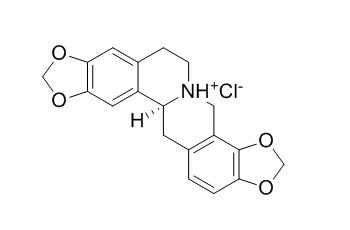Stylopine hydrochloride
Stylopine is a protoberberine-type alkaloid that has potential biological activities, including anti-inflammatory activity.
Inquire / Order:
manager@chemfaces.com
Technical Inquiries:
service@chemfaces.com
Tel:
+86-27-84237783
Fax:
+86-27-84254680
Address:
1 Building, No. 83, CheCheng Rd., Wuhan Economic and Technological Development Zone, Wuhan, Hubei 430056, PRC
Providing storage is as stated on the product vial and the vial is kept tightly sealed, the product can be stored for up to
24 months(2-8C).
Wherever possible, you should prepare and use solutions on the same day. However, if you need to make up stock solutions in advance, we recommend that you store the solution as aliquots in tightly sealed vials at -20C. Generally, these will be useable for up to two weeks. Before use, and prior to opening the vial we recommend that you allow your product to equilibrate to room temperature for at least 1 hour.
Need more advice on solubility, usage and handling? Please email to: service@chemfaces.com
The packaging of the product may have turned upside down during transportation, resulting in the natural compounds adhering to the neck or cap of the vial. take the vial out of its packaging and gently shake to let the compounds fall to the bottom of the vial. for liquid products, centrifuge at 200-500 RPM to gather the liquid at the bottom of the vial. try to avoid loss or contamination during handling.
J Liq Chromatogr R T2018, 41(12):761-769
J Ethnopharmacol.2016, 194:219-227
Analytical Letters.2020, doi 10.1008
Journal of Holistic Integrative Pharmacy2024, 5(1):45-55.
Plants (Basel).2020, 9(11):1422.
HortTechnology2016, 26(6):816-819
Korean j.of Pharm.2017, 70-76
Cell Prolif.2021, 54(8):e13083.
Molecules.2024, 29(21):5161.
J Pharm Biomed Anal.2024, 247:116257.
Related and Featured Products
Arch Pharm Res. 2004 Sep;27(9):923-9.
Stylopine from Chelidonium majus inhibits LPS-induced inflammatory mediators in RAW 264.7 cells.[Pubmed:
15473662]
Stylopine is a major component of the leaf of Chelidonium majus L. (Papaveraceae), which has been used for the removal of warts, papillomas and condylomas, as well as the treatment of liver disease, in oriental countries.
METHODS AND RESULTS:
Stylopine per se had no cytotoxic effect in unstimulated RAW 264.7 cells, but concentration-dependently reduced nitric oxide (NO), prostaglandin E2 (PGE2), tumor necrosis factor-alpha (TNF-alpha) and interleukin-1beta (IL-1beta), and the IL-6 production and cyclooxygenase-2 (COX-2) activity caused by the LPS stimulation. The levels of inducible nitric oxide synthase (iNOS) and COX-2 protein expressions were markedly suppressed by stylopine in a concentration dependent manner.
CONCLUSIONS:
These results suggest that stylopine suppress the NO and PGE2 production in macrophages by inhibiting the iNOS and COX-2 expressions. These biological activities of stylopine may contribute to the anti-inflammatory activity of Chelidonium majus.



